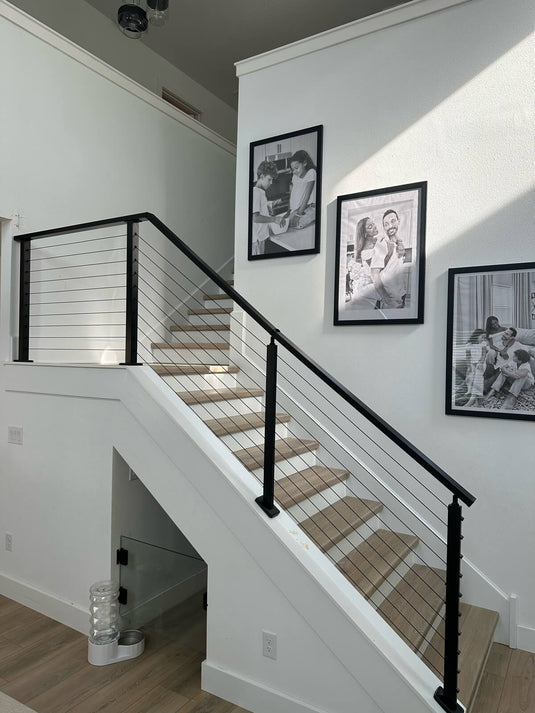TABLE OF CONTENTS
Cable Railing System Codes: What You Need to Know
Railings are an essential part of building structures, providing safety and defining boundaries. When constructing or remodeling a home, whether for staircases, decks, or balconies, ensuring that the railings meet building code requirements is essential. Moreover, over time, the decorative function of railings has gradually become more prominent, playing a significant role in users' home designs. Therefore, selecting railing designs that meet safety standards while enhancing aesthetic appeal has become a key consideration in modern home design.

About Railing Code
What is the Building Code?
Building codes refer to a set of regulations and standards designed to ensure the safety, functionality, and sustainability of structures. These codes are typically established by government authorities or professional organizations and cover various aspects of construction. Building codes have a long history. The earliest known written building code is included in the Code of Hammurabi, which dates from circa 1772 BC.
The Main Sources of Railing Code Requirements
① The IBC(The 2024 International Building Code)
② The IRC(The 2024 International Residential Code)
③ The IFC(The 2024 International Fire Code)
For codes specific to a state, you can visit the International Code Council website, your state government’s website, or the local building department's website for detailed information.
The Importance of Railing Compliance
● Providing Essential Support:
In stairways and deck areas, code-compliant railings with sufficient load-bearing capacity offer reliable support, making it easier for seniors and children to navigate these spaces safely.
● Preventing Accidental Falls:
Building codes strictly regulate railing height, spacing, and strength to effectively prevent falls from elevated areas in a variety of settings.
● Protecting Children and Seniors:
Building codes include specific design requirements, such as minimum railing height and post spacing, to prevent children from slipping through or getting stuck, while ensuring safety for seniors and those with mobility challenges.
The Handrail & Guard in the Railing System
Handrails, guardrails, and railings are often mistaken for one another, yet both handrails and guardrails are essential components of a complete railing system. Both the International Building Code (IBC) and the International Residential Code (IRC) have definitions for “guards” and “handrails”, described below:
Handrail:
A horizontal or sloping rail intended for grasping by the hand for guidance or support. It must be graspable and continuous to aid in balance and prevent falls.
Guards:
A building component or a system of building components located at or near the open sides of elevated walking surfaces that minimizes the possibility of a fall from the walking surface to a lower level. A standard guardrail shall consist of the top rail, equivalent protection, and posts.
Specific Codes for Handrail & Guards in Railings
1. Where Installation is Required
Handrail Code |
1. Handrails shall be provided on not less than one side of each flight of stairs with 4 or more risers. 2. Stairways less than 44 inches in width may have one handrail or stair railing except that such stairways open on one or both sides shall have stair railings provided on the open side or sides. 3. Stairways shall have handrails or stair railings on each side, and every stairway required to be more than 88 inches in width shall be provided with not less than one intermediate stair railing for every 88 inches of required width. Intermediate stair railings shall be spaced approximately equal to the entire width of the stairway. 4. Flights of stairways within dwelling units and flights of spiral stairways are permitted to have a handrail on one side only. 5. Handrail shall be provided on not less than one side of ramps exceeding a slope of 1 unit vertical in 12 units horizontal. |
Guard Code |
1. Guards shall be provided for those portions of open-sided walking surfaces, including floors, stairs, ramps, and landings that are located more than 30inches(762mm) measured vertically to the floor or grade below at any point within 36 inches (914mm) horizontally to the edge of the open side. |
2. Handrail & Guard Height
| Residential | Commercial | |
| Handrail Height Code | Handrail height, measured from a line connecting the nosings of flights of stairs or the finished surface of the ramp slope, shall be uniform. Not less than 34 inches(864mm) and not more than 38 inches(965mm). |
------ |
| Guard Height Code | 1. Required guards at open-sided walking surfaces, including stairs, porches, balconies, or landings, shall be not less than 36 inches (914mm) in height. 2. The open sides of stairs shall have a height of not less than 34 inches (864mm). 3. where the top of the guard serves as a handrail on the open sides of stairs, the top of the guard shall not be less than 34 inches (864mm) and not more than 38 inches (965mm). |
1. Required guards shall be not less than 42 inches(1067mm) in height. |
3. Load-Bearing Requirements
Loads on Handrail & Guards:
Shall be designed to resist a concentrated load of 200 pounds (0.89KN). The mounting of handrails shall be such that the completed structure is capable of withstanding a load of at least 200 pounds applied in any direction at any point on the rail.
4. Handrail Continuity
For Residential:
Handrail shall be continuous for the full length of the flight, from a point directly above the nosing of the landing at the top of the flight to a point directly above the lowest nosing of the flight.
Exception: Handrail continuity shall be permitted to be interrupted by a newel post at a turn in a flight with winders, at a landing, or over the lowest tread.
5. Opening Limitation
| Handrail | 1. The handrail adjacent to a wall shall have a space of not less than 1 1/2 inches (38mm) between the wall and the handrails. |
| Guard |
1. Required guards shall not have openings from the walking surface to the required guard height that allow passage of a sphere 4 inches(102mm) in diameter.  |
About Muzata Cable Railings
Among the wide variety of railing options available, Muzata’s cable railing stands out with its sleek, industrial aesthetic and minimalist design that ensures structural integrity. Known for its sturdy construction and precision engineering, the Muzata metal cable railing system combines a robust metal framework with carefully spaced cables, creating a secure barrier that elevates safety standards. Beyond offering reliable protection, this system adds a stylish, modern touch that seamlessly complements any decor while keeping safety at the forefront.

Are Muzata Cable Railings Safe?
Muzata’s cable railing posts are designed to comply with code standards, ensuring proper post height, cable spacing, post spacing, and tensioning range for safe installation. These features make Muzata an ideal choice for residential or commercial handrails, offering both security and durability. With a focus on quality and adherence to safety guidelines, Muzata’s cable railing systems provide peace of mind, making them a trusted option for any railing project.
How Muzata Cable Railings Meet Code Requirements?
① About the Height Design of the Railing System
In most states, residential railing height requirements are 36''. However, there are exceptions, such as in California, where residential railings must be at least 42 inches high. For commercial and international buildings, the standard railing height requirement is generally 42 inches, which can be measured from the floor or from the top edge of the railing, depending on the installation. The specified height should be the distance from the ground to the top of the railing.
② About the Spacing Design of the Railing System
Post Spacing
To meet code requirements, the distance between the centers of each post should not exceed 4 feet. For cable railing systems, additional intermediate supports should be installed every 4 feet (non-load-bearing posts). The maximum spacing for wooden posts is 6 feet. Typically, the recommended spacing between posts is around 3-4 feet.
Cable Spacing
The Muzata railing system is designed with 3" cable spacing. The 36'' high railing system uses 10 horizontal steel cables, while the 42'' uses 12 horizontal steel cables.
The Maximum Tightening Distance of the Tensioners
| CB05 | 20FT |
| CB40 | 20FT |
| CR73 | 20FT |
| CK07 | 35FT |
The above configurations ensure the railing spacing complies with building codes [passing the 4-inch and 6-inch sphere tests].
③ About the Strength Design of the Railing System
The railing system must be capable of supporting a concentrated load of at least 200 pounds applied at any point along the top rail, or a distributed load of at least 50 pounds per linear foot.
Properly installing a tensioned Muzata cable railing system ensures compliance with the legal requirements.
The installation of the Muzata cable railing is divided into 4 main steps:
1. Determine the post locations, drill holes, and securely install the posts.
2. Install brackets to connect and support the handrails.
3. Cut the handrails to the correct size and install them.
4. Install tensioners and cables, then tighten the cables in the specified order.
Follow the sequence to tighten other cable runs. Begin with the center cable and alternately tighten the upper and lower cables to maintain optimal stability in the system.

Elevate Your Space with Muzata’s High-Quality Cable Railing
Muzata offers a diverse selection of premium railing products that not only meet safety codes but also enhance the beauty and functionality of your space. Whether it's a residential or commercial project, Muzata provides expert solutions that ensure every detail is flawlessly executed. If you're seeking a durable, code-compliant railing system, our products are the perfect fit. Explore our product today and start your journey toward the ideal railing!
Free Design Service for Cable Railing >>>>> Get a Quote





